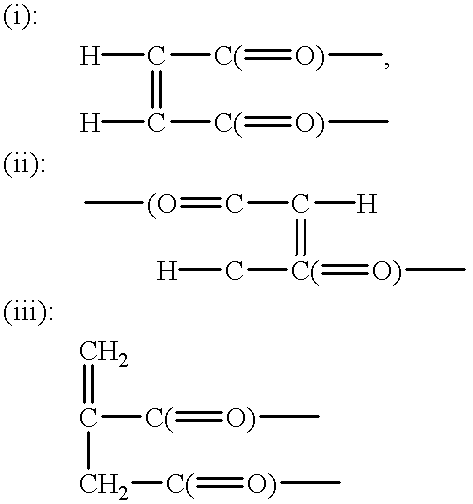Ether compound, production thereof and curable compositions
a technology of ether compound and composition, which is applied in the separation/purification of carboxylic acid esters, organic chemistry, etc., can solve the problems of limiting the number of really available catalysts, toxicity problems, and remaining tack, and achieve excellent adhesion to the substrate, efficient and easy production, and excellent tack properties.
- Summary
- Abstract
- Description
- Claims
- Application Information
AI Technical Summary
Benefits of technology
Problems solved by technology
Method used
Image
Examples
example 1
144 g (1 mol) of dimethyl fumarate, 245 g (2.4 mol) of ethylene glycol monopropenyl ether, 0.2 g of zinc acetate and 0.3 g of tetrakis[methylene-3-(3,5-di-t-butyl-4-hydroxyphenyl)propionato]methane (trade name "Irganox 1010" available from Japan Ciba-Geigy, hereinafter also referred to simply as "Irganox 1010") as a polymerization inhibitor were charged into a 1 lit. flask equipped with distillation column. The mixture was heated at 140.degree. C. in a nitrogen atmosphere, and a reaction was effected for 8 hr. Secondarily produced methanol was distilled off. When the amount of methanol reached 70% of the theoretical amount, the pressure inside the reaction system was gradually reduced to thereby accelerate the removal of methanol by distillation. The pressure was finally reduced to about 400 Pa, thereby completely distilling off the theoretical amount of methanol and any remaining ethylene glycol monopropenyl ether. The reaction mixture was cooled to room temperature, and 283 g of p...
example 2
144 g (1 mol) of dimethyl fumarate, 245 g (2.4 mol) of ethylene glycol monoallyl ether, 0.2 g of zinc acetate and 0.05 g of Irganox 1010 as a polymerization inhibitor were charged into a 1 lit. flask equipped with distillation column. The mixture was heated at 140.degree. C. in a nitrogen atmosphere for 8 hr. Secondarily produced methanol was distilled off. When the amount of methanol reached 70% of the theoretical amount, the pressure inside the reaction system was gradually reduced to thereby accelerate the removal of methanol by distillation. The pressure was finally reduced to about 400 Pa, thereby completely distilling off the theoretical amount of methanol and any remaining ethylene glycol monoallyl ether. The reaction mixture was cooled to room temperature, and 283 g of product was recovered. The obtained product was analyzed by .sup.1 H-NMR and IR, and it was found that the product was bis(2-allyloxyethyl) fumarate.
.sup.1 H-NMR; .delta.(ppm) 6.90 (s, 2H, --OCOCH.dbd.CHCOO--)...
example 3
98 g (1 mol) of maleic anhydride, 245 g (2.4 mol) of ethylene glycol monoallyl ether, 200 ml of benzene and 0.5 g of sulfuric acid were charged into a 1 lit. glass flask equipped with an agitator, a thermometer, a condenser and a water determining receiver. The mixture was heated on an oil bath under agitation. The reaction temperature was raised to 80.degree. C., and the reaction was continued while distilling off water secondarily produced in accordance with the progress of the reaction. When the amount of water distilled off reached the theoretical amount, the reaction was terminated, followed by cooling. The thus obtained reaction mixture was transferred into a separatory funnel. 300 ml of benzene was added thereto, and separatory washing was conducted with the use of a 10% aqueous sodium carbonate solution and water. Thereafter, the reaction mixture was purified by vacuum distillation. 241 g of product was obtained by distillation at 150 to 155.degree. C. / 133 Pa.
The obtained pr...
PUM
| Property | Measurement | Unit |
|---|---|---|
| wt % | aaaaa | aaaaa |
| wt % | aaaaa | aaaaa |
| temperature | aaaaa | aaaaa |
Abstract
Description
Claims
Application Information
 Login to View More
Login to View More - R&D
- Intellectual Property
- Life Sciences
- Materials
- Tech Scout
- Unparalleled Data Quality
- Higher Quality Content
- 60% Fewer Hallucinations
Browse by: Latest US Patents, China's latest patents, Technical Efficacy Thesaurus, Application Domain, Technology Topic, Popular Technical Reports.
© 2025 PatSnap. All rights reserved.Legal|Privacy policy|Modern Slavery Act Transparency Statement|Sitemap|About US| Contact US: help@patsnap.com

